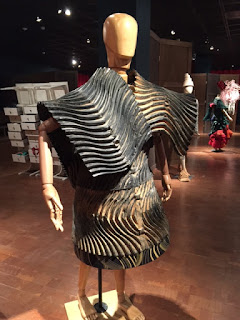While some of these pieces (especially the one with the hand coming out of the head) were hard to look at initially because of how disturbing they seemed, they actually showed very interesting ways to rearrange parts of the human body. After looking at the pieces some more, I noticed that I found them to be extremely intriguing. Unfortunately, I do not see how they create commentary on illness and ageing, but perhaps I am missing something. I can definitely say however that these pieces are memorable.
On the other hand, the "Gagawaka" exhibit contained haute couture fashion. Below is one piece that I found to be interesting.
This is supposed to be strange haute couture fashion, and I can definitely see that. The material and shaping of the dress makes it seem like it would be impossible to wear in reality, which is similar to some other haute couture pieces.
I think the combination of "Gagawaka" and "Postmortem" was interesting, because they do not seem to be related at all. The only resemblance I noticed between the two exhibits is that they were both eye-catching, original, and shocking. Overall, I would recommend this exhibit to students if they want to see something interesting and provocative. However, I did not fully understand the meaning of the two exhibits, and that is why I cannot recommend "Making Strange" to people where it is not as easy to visit the Fowler Museum. I think the title of the exhibit agrees with my description of the pieces: strange.
















%2B-Portrait%2Bof%2Ba%2BYoung%2BWoman%2Bin%2Ba%2BTurban.jpg)






